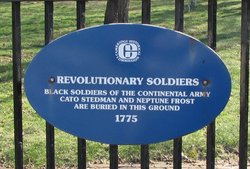The Grave of Cato Stedman/Freeman
Earlier this month the Cambridge Chronicle reported on the mystery of Cato Stedman/ Freeman’s gravesite.
Cambridge records show that Cato Stedman was buried in the public cemetery across from the common. A historical marker memorializes him as well as Neptune Frost, a fellow Continental Army veteran. (That marker includes the date of 1775, but that’s not when they died.)
Ruth Wallis Herndon collected information on Stedman/Freeman in her book Unwelcome Americans. She reports that he was owned as a child and young man by tavern owner and militia captain Ebenezer Stedman of Cambridge. Cato served in the town militia company at the start of the war and became free about the time of the Battle of Bunker Hill in June 1775. He then enlisted in Col. Thomas Gardner’s regiment of the Continental Army under the name of Cato Freeman.
In his report on soldiers of color in the early Continental Army, George S. Quintal states that Stedman is “also listed on a 27 May 1777 roll as having joined the Continental Army from Cambridge, for the length of the war.” His regiment, commanded by Col. William Shepard, served in the Saratoga campaign.
Herndon, however, writes that Freeman/Stedman was at Valley Forge in 1777-78, followed by West Point in 1781. That appears to be based on information the veteran gave to Cranston, Rhode Island, authorities in the early 1800s when he became impoverished. Those authorities sent him back to his original home parish of Cambridge, which is why he was back there using the name Cato Stedman when he died.
Lesley University student Jonathan Hill has noted that sources from the early 1900s say Cato Stedman was buried either in the Stedman family tomb or in a plot next to his former owner. Hill therefore posits that the now-unmarked space next to Ebenezer Stedman’s grave is where Cato Stedman was buried. Unfortunately, a tradition first in print a century after a man’s death isn’t the strongest evidence.
The Cambridge city council has voted to have officials seek more information about Stedman/Freeman and Frost to determine their specific grave sites and mark them. The head of the city’s historical commission isn’t certain that enough evidence will come to light to make that possible. Meanwhile, the veterans’ names continue to appear prominently on the cemetery fence.
Cambridge records show that Cato Stedman was buried in the public cemetery across from the common. A historical marker memorializes him as well as Neptune Frost, a fellow Continental Army veteran. (That marker includes the date of 1775, but that’s not when they died.)
Ruth Wallis Herndon collected information on Stedman/Freeman in her book Unwelcome Americans. She reports that he was owned as a child and young man by tavern owner and militia captain Ebenezer Stedman of Cambridge. Cato served in the town militia company at the start of the war and became free about the time of the Battle of Bunker Hill in June 1775. He then enlisted in Col. Thomas Gardner’s regiment of the Continental Army under the name of Cato Freeman.
In his report on soldiers of color in the early Continental Army, George S. Quintal states that Stedman is “also listed on a 27 May 1777 roll as having joined the Continental Army from Cambridge, for the length of the war.” His regiment, commanded by Col. William Shepard, served in the Saratoga campaign.
Herndon, however, writes that Freeman/Stedman was at Valley Forge in 1777-78, followed by West Point in 1781. That appears to be based on information the veteran gave to Cranston, Rhode Island, authorities in the early 1800s when he became impoverished. Those authorities sent him back to his original home parish of Cambridge, which is why he was back there using the name Cato Stedman when he died.
Lesley University student Jonathan Hill has noted that sources from the early 1900s say Cato Stedman was buried either in the Stedman family tomb or in a plot next to his former owner. Hill therefore posits that the now-unmarked space next to Ebenezer Stedman’s grave is where Cato Stedman was buried. Unfortunately, a tradition first in print a century after a man’s death isn’t the strongest evidence.
The Cambridge city council has voted to have officials seek more information about Stedman/Freeman and Frost to determine their specific grave sites and mark them. The head of the city’s historical commission isn’t certain that enough evidence will come to light to make that possible. Meanwhile, the veterans’ names continue to appear prominently on the cemetery fence.


No comments:
Post a Comment